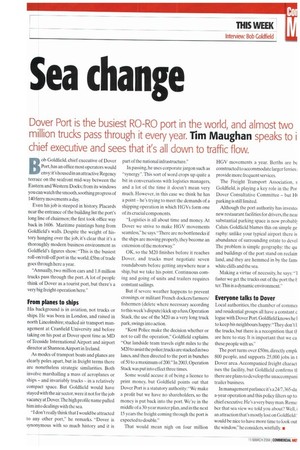Sea change
Page 25

If you've noticed an error in this article please click here to report it so we can fix it.
Bob Goldfield. chief executive of Dover Port,has an office most operators would envy: it's housed in an attractive Regency terrace on the seafront mid-way between the Eastern and Western Docks; from its windows you can watch the smooth, soothing progress of 140 ferry movements a day.
Even his job is steeped in history. Placards near the entrance of the building list the port's long line of chairmen; the first took office way back in 1606. Maritime paintings hang from Goldfield's walls. Despite the weight of history hanging over the job, it's clear that it's a thoroughly modern business environment as Goldfield's figures show: "This is the busiest roll-on/roll-off port in the world f.5bn of trade goes through here a year.
"Annually, two million cars and 1.8 million trucks pass through the port. A lot of people think of Dover as a tourist port, but there's a very big freight operation here."
From planes to ships
His background is in aviation, not trucks or ships. He was born in London, and raised in north Lincolnshire; studied air transport management at Cranfield University and before taking on his post at Dover spent time as MD of Teesside International Airport and airport director at Shannon Airport in Ireland.
As modes of transport boats and planes are clearly poles apart, but in freight terms there are nonetheless strategic similarities. Both involve marshalling a mass of aeroplanes or ships — and invariably trucks — in a relatively compact space. But Goldfield would have stayed with the air sector, were it not for the job vacancy at Dover.The high profile name pulled him into dealings with the sea.
"I don't really think that I would be attracted to any other port," he remarks. "Dover is synonymous with so much history and it is part of the national infrastructure."
In passing. he uses corporate jargon such as -synergy". This sort of word crops up quite a bit in conversations with logistics managers. and a lot of the time it doesn't mean very much. However, in this case we think he has a point — he's trying to meet the demands of a shipping operation in which HGVs form one of its crucial components.
"Logistics is all about time and money. At Dover we strive to make HGV movements seamless." he says. "There are no bottlenecks if the ships are moving properly, they become an extension of the motorway."
OK, so the M20 finishes before it reaches Dover, and trucks must negotiate seven roundabouts before getting anywhere near a ship, but we take his point. Continuous coming and going of units and trailers requires constant sailings.
But if severe weather happens to prevent crossings, or militant French dockers/farmers/ fishermen (delete where necessary according to this week's dispute) kick up a fuss, Operation Stack, the use of the M20 as a very long truck park, swings into action.
"Kent Police make the decision whether or not to call the operation," Goldfield explains. "Our landside team travels eight miles to the M20 to assist the policettrucks are stacked in two lanes, and then directed to the port in bunches of 50 to a maximum of 200." In 2003, Operation Stack was put into effect three times.
Some would accuse it of being a licence to print money. but Goldfield points out that Dover Port is a statutory authority: "We make a profit but we have no shareholders, so the money is put back into the port. We're in the middle of a 30-year master plan. and in the next 15 years the freight coming through the port is expected to double."
That would mean nigh on four million HGV movements a year. Berths are be constructed to accommodate larger ferries ; provide more frequent services.
The Freight Transport Association, s Goldfield, is playing a key role in the Por Dover Consultative Committee — but Ht parking is still limited.
Although the port authority has investe( new restaurant facilities for drivers, the nem substantial parking space is now probabl■ Calais. Goldfield blames this on simple ge raphy: unlike your typical airport there is abundance of surrounding estate to devel The problem is simple geography: the qu and buildings of the port stand on reclain land, and they are hemmed in by the fam( white cliffs and the sea.
Making a virtue of necessity, he says:"] faster we get the trucks out of the port the t ter.This is a dynamic environment."
Everyone talks to Dover
Local authorities, the chamber of commei and residential groups all have a constant c logue with Dover Port. Goldfield knows he to keep his neighbours happy: "They don't 11 the trucks, but there is a recognition that if are here to stay. It is important that we ca. these people with us."
The port turns over £50m. directly emplc 800 people, and supports 25,000 jobs in t Dover area. Accompanied freight charact ises the facility, but Goldfield confirms ti there are plans to develop the unaccompani trailer business.
In management parlance it's a 2417,365-da a-year operation and this policy filters up to chief executive. He's a very busy man. Reme: ber that sea view we told you about? Well, i an attraction that's mostly lost on Goldfield:' would be nice to have more time to look out the window." he considers. wistfully. •
































































































































































































